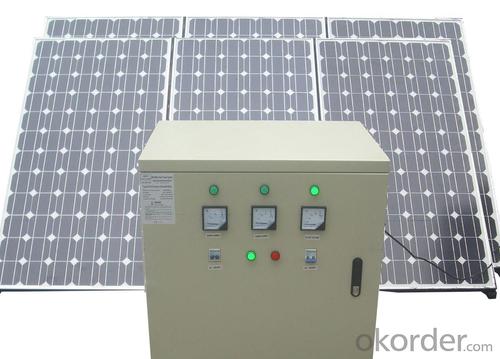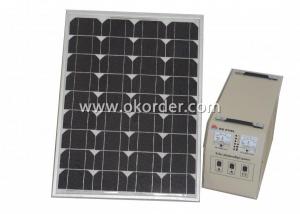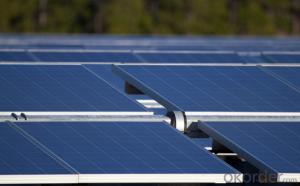CNBM Solar Home System CNBM-K6 (1KW) - Solar Energy Systems Perth
- Loading Port:
- China Main Port
- Payment Terms:
- TT or L/C
- Min Order Qty:
- 1 set set
- Supply Capability:
- 1000 sets per month set/month
OKorder Service Pledge
OKorder Financial Service
You Might Also Like
Brief Introduction of Solar Energy System CNBM-K6 (1KW)
CNBM Home System-K6 (1KW) has a wonderful capacity.It can be used in factory,home,school and other CNBM Home System-K6 (1KW) consist of the solar modules,charge controller,inverter and battery banks.
CNBM International is highly recognized by its business partners and clients all over the world and has obtained rapid development under the spirit of win-win .
With CNBM Home System-K6 (1KW),
We will carry on the mutual beneficial,innovative and revolutionary trading structure as we did before,create value for our employees,share holders and clients and benefit the whole society in our future development.Please contact us ,if you have interest in CNBM Home System-K6 (1KW),don’t hesitate!
The Sketching of Solar Energy System CNBM-K6 (1KW)
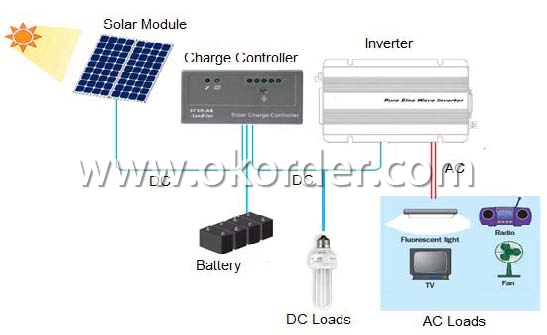
Components of Solar Energy System CNBM-K6 (1KW)
PV Array:
Convert sunlight instantly into DC electric power. Formed by the solar modules (also called photovoltaic modules) in accordance with the system requirements for series and parallel.
Solar Charge Controller:
A charge controller may be used to power DC equipment with solar panels. The charge controller provides a regulated DC output and stores excess energy in a battery as well as monitoring the battery voltage to prevent over charge or over discharge. An inverter can be connected to the output of a charge controller to drive AC loads.
Inverter:
Converts DC output power of photovaltaic soalr panels into standard AC power for use in the local off-grid electrical network. It is a critical component in a photovoltaic system, allowing the use of ordinary commercial appliances.
Battery banks:
Stores energy when there is an excess coming in and distribute it back out when there is a demand. Solar PV panels continue to re-charge batteries each day to maintain battery charge.
Technical data of Solar Home System CNBM-K6 (1KW) | ||
Inverter | Rated load power | 1500W |
Output wave | Pure sine wave | |
Output voltage | DC 24V | |
Output frequency |
AC:220V | |
Precision of output | 50HZ/60HZ | |
Precision of output frequency | ±6% | |
Solar panel | Pmax | 165W*6PCS |
Vmp | 36V | |
Imp | 4.58A*6 | |
Charger | Charger voltage & current | 24V /20A*3 |
Battery | Capacity | 12V 250AH*2PCS |
Power box | Spray paint iron box,with input,output,ammeter,voltmeter,master swith and so on. | |
Package of Solar Home System CNBM-K6 (1KW) | ||||
Part | Size(L*W*H mm) | Weight(kg) | 20’(pcs) | 40’(pcs) |
Power box | 800*540*780 | 70 | 48 Sets | 65 Sets |
Solar panel | 1600*830*90 | 90 | ||
Battery | 540*520*350 | 200 | ||
Factory Picture of Solar Energy System CNBM-K6 (1KW)
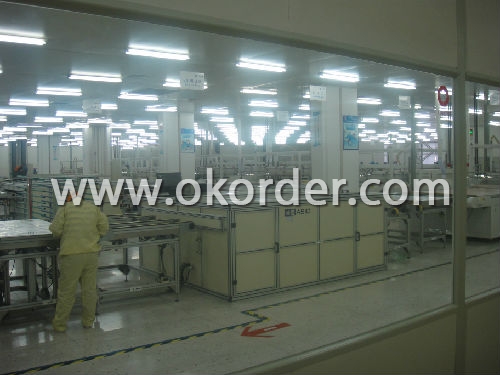
Package Picture of Solar Energy System CNBM-K6 (1KW)
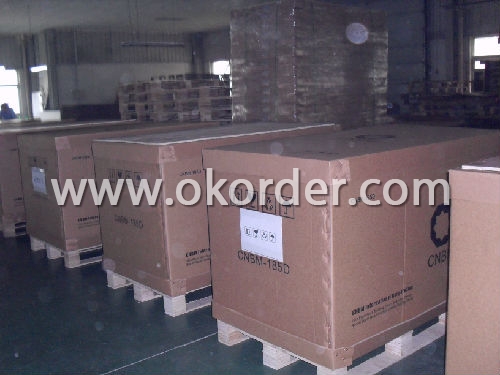
- Q: How do solar energy systems affect the resale value of homes?
- Solar energy systems can have a positive impact on the resale value of homes. Studies have shown that homes equipped with solar panels tend to sell for higher prices and at a faster rate compared to homes without solar installations. This is because solar energy systems offer long-term savings on electricity bills, making the property more attractive to potential buyers. Additionally, the environmental benefits of solar energy can also enhance the perceived value of a home, especially in today's environmentally conscious market.
- Q: Are there any disadvantages to using solar energy?
- Certainly, there exist a few drawbacks to the utilization of solar energy. One significant drawback pertains to the initial expense associated with the installation of solar panels. Acquiring and setting up solar panels can be rather costly, rendering it challenging for certain individuals or businesses to afford. Furthermore, the effectiveness of solar panels can be influenced by various elements such as weather conditions and the angle and orientation of the panels. Consequently, solar energy may not be as dependable in regions with limited sunlight or on cloudy days. Another disadvantage is the necessity for a substantial amount of space to accommodate the installation of solar panels, which may not be feasible for those residing in densely populated urban areas. Lastly, solar energy production is intermittent, signifying that it cannot be generated at night or during overcast periods without the employment of battery storage systems or alternative energy sources.
- Q: Can solar energy systems be used in powering agricultural irrigation systems?
- Yes, solar energy systems can be used to power agricultural irrigation systems. Solar energy can be harnessed through photovoltaic panels or solar thermal systems to generate electricity or heat, respectively. This energy can then be utilized to power pumps, motors, and other components necessary for irrigation, reducing the reliance on grid electricity or diesel generators. Solar-powered irrigation systems are sustainable, cost-effective, and can be particularly beneficial in remote or off-grid agricultural areas.
- Q: Can solar energy systems be used for powering electric car wash systems?
- Yes, solar energy systems can indeed be used to power electric car wash systems. By installing solar panels, the energy from the sun can be harnessed and converted into electricity to power the car wash equipment. This renewable energy source offers an eco-friendly and sustainable alternative to traditional electricity sources.
- Q: How much space is required to install a solar energy system?
- The amount of space required to install a solar energy system depends on various factors, such as the system's capacity and the available sunlight. On average, a small-scale residential solar system typically requires around 100-400 square feet of space. However, larger commercial or utility-scale systems might need several acres of land. Additionally, the installation can also be done on rooftops, utilizing available space without requiring additional land.
- Q: How does the efficiency of solar panels vary across different installation locations?
- The efficiency of solar panels varies across different installation locations due to various factors such as the amount of sunlight received, the angle and orientation of the panels, shading, temperature, and local weather conditions.
- Q: Can solar energy systems be used for powering off-grid research facilities?
- Yes, solar energy systems can definitely be used to power off-grid research facilities. Solar panels can generate electricity by capturing the sun's energy, which can then be stored in batteries for later use. This makes solar power a reliable and sustainable option for off-grid research facilities, providing a constant source of electricity without the need for traditional power grids. Additionally, solar energy systems can be easily installed in remote areas, making it an ideal choice for powering research facilities located in off-grid or isolated locations.
- Q: How much does it cost to install a solar energy system?
- The cost of installing a solar energy system can vary depending on several factors such as the size of the system, location, and specific project requirements. On average, residential solar installations can cost anywhere between $15,000 to $25,000 or more. However, it's important to note that there are also various financial incentives, tax credits, and financing options available that can help offset the initial cost and make solar energy more affordable for homeowners and businesses.
- Q: Can solar energy systems be used in powering fire stations or police stations?
- Yes, solar energy systems can certainly be used to power fire stations or police stations. Solar panels can be installed on the rooftops of these buildings to harness sunlight and convert it into electricity. This renewable energy source can help reduce the reliance on traditional power grids and lower operational costs for these facilities. Additionally, solar energy systems can ensure a more sustainable and environmentally friendly power source for fire and police stations.
- Q: Can solar energy systems be used to power electric vehicles?
- Yes, solar energy systems can be used to power electric vehicles. Solar panels can be installed on the vehicle or on a separate structure to generate electricity which can be stored in batteries and used to charge the electric vehicle's battery. This allows for clean and renewable energy to be used for transportation.
Send your message to us
CNBM Solar Home System CNBM-K6 (1KW) - Solar Energy Systems Perth
- Loading Port:
- China Main Port
- Payment Terms:
- TT or L/C
- Min Order Qty:
- 1 set set
- Supply Capability:
- 1000 sets per month set/month
OKorder Service Pledge
OKorder Financial Service
Similar products
Hot products
Hot Searches
Related keywords



